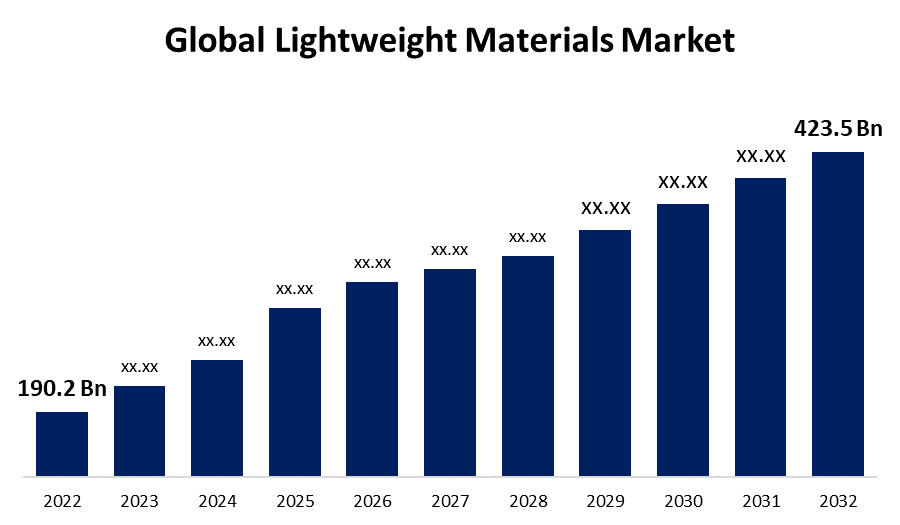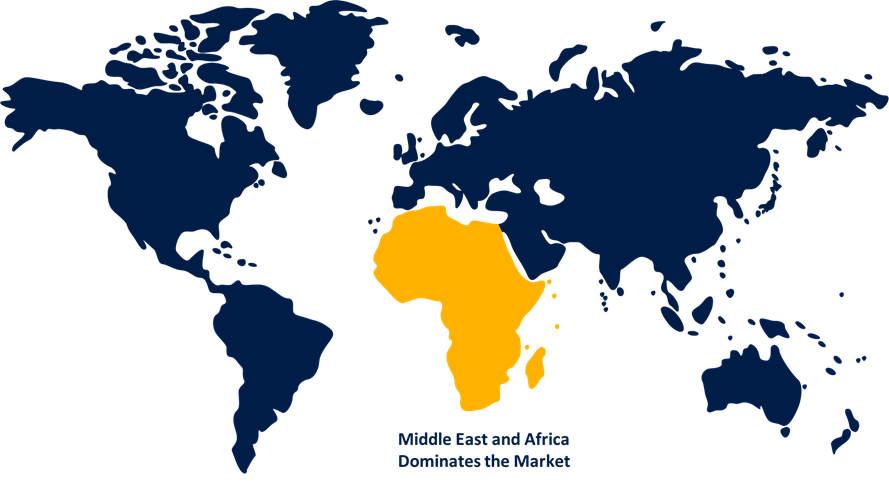Global Lightweight Materials Market Size, Share, and COVID-19 Impact Analysis, By Product (Metal Alloys, Composites & Polymers), By Application (Automotive, Aviation, Energy, & Others), By Region (North America, Europe, Asia-Pacific, Latin America, Middle East, and Africa), Analysis and Forecast 2022 - 2032.
Industry: Advanced MaterialsGlobal Lightweight Materials Market Insights Forecasts to 2032
- The Global Lightweight Materials Market Size was valued at USD 190.2 Billion in 2022.
- The Market is Growing at a CAGR of 8.3% from 2022 to 2032.
- The worldwide Lightweight Materials Market size is expected to reach USD 423.5 Billion by 2032.
- Asia Pacific is expected to Grow the fastest during the forecast period.

Get more details on this report -
The Global Lightweight Materials Market Size is expected to reach USD 423.5 Billion by 2032, at a CAGR of 8.3% during the forecast period 2022 to 2032.
Market Overview
Lightweight materials are frequently made of metal alloys and composites to reduce the weight of vehicles, airplanes, and wind turbines while keeping the strength and efficiency of the structure. High strength-to-weight ratio, increased corrosion resistance, and more design freedom are all provided by lightweight materials. These materials, which include metal alloys, polymers, and composites, give vehicle and aviation parts greater mechanical strength and durability. The best materials for use in the automotive and aerospace sectors include advanced carbon-fiber-reinforced plastics, magnesium alloys, aluminum, and high-strength steel. The effectiveness of lightweight materials is determined by the mixture of metals or composites employed during manufacturing. They are utilized to create lightweight cars, aircraft, packaging, and medical equipment and exist in a variety of designs and grades. Many manufacturers are transitioning to products that are lighter cars because of the growing awareness of gasoline emissions, which is predicted to boost global business. The production of numerous vehicle parts frequently makes use of lightweight materials such as metal alloys, composites, and polymers.
Report Coverage
This research report categorizes the global lightweight materials market based on various segments and regions and forecasts revenue growth and analyses trends in each submarket. The report analyses the key growth drivers, opportunities, and challenges influencing the global lightweight materials market. Recent market developments and competitive strategies such as expansion, product launch, and development, partnership, merger, and acquisition have been included to draw the competitive landscape in the market. The report strategically identifies and profiles the key market players and analyses their core competencies in each sub-segment of the global lightweight materials market. Technological innovation and advancement will further optimize the performance of the product, enabling it to acquire a wider range of applications in the downstream market.
Global Lightweight Materials Market Report Coverage
| Report Coverage | Details |
|---|---|
| Base Year: | 2021 |
| Market Size in 2021: | USD 190.2 Billion |
| Forecast Period: | 2022-2032 |
| Forecast Period CAGR 2022-2032 : | 8.3% |
| 2032 Value Projection: | USD 423.5 Billion |
| Historical Data for: | 2020-2021 |
| No. of Pages: | 200 |
| Tables, Charts & Figures: | 120 |
| Segments covered: | By Product, By Application, By Region. |
| Companies covered:: | ThyssenKrupp AG, Henkel Corporation, Owens Corning Corporation, LyondellBasell Industries N.V., Hexcel Corporation, SGL Group, Nippon Graphite Fiber Corporation, Mitsubishi Rayon Co. Ltd., Zoltek Companies Inc, UC Rusal, Aluminium Corporation of China, Rio Tinto Alcan Inc., China Hongqiao Group Ltd., Kaiser Aluminium, US Magnesium LLC, A&S Magnesium Inc. |
| Pitfalls & Challenges: | COVID-19 Empact, Challenge, Future, Growth, & Analysis |
Get more details on this report -
Driving Factors
The market for lightweight materials is being driven by an increase in demand in various industrial sectors. The automobile, aerospace, and energy sectors all significantly benefit from the use of lightweight materials. Additionally, the automobile industry has experienced tremendous growth as a result of factors such as rising disposable income, technical advancement, an uptick in new product innovations, and an increase in the overall number of aftermarkets and OEMs. Another factor boosting the industry is the introduction of strict pollution and fuel standards for automobiles by governments throughout the world. Moreover, Electric cars are more in demand internationally because of their affordability, fuel economy, and operational efficiency. Due to their high strength and lightweight components, electric automobiles are highly popular with consumers. Parts of electric vehicles are often constructed from lightweight materials such as exceptionally strong steel, magnesium (Mg) alloys, aluminum (Al) alloys, and tailored polymers to reduce the weight of the vehicles. In comparison to traditional cars, lightweight automobiles offer the best fuel efficiency. Low-power engines used in electric automobiles require lightweight components to drive an engine's pulling capabilities.
Restraining Factors
The main challenge to the market for lightweight materials is the cost of materials such as reinforced composites, titanium, and magnesium. The use of lightweight materials is restricted in several end-use sectors, including automotive, aircraft manufacturing, wind turbines, and marine. Also, due to variables including the fast changes in raw material costs and the expensive cost of carbon fiber may restrict the growth. For example, according to a report by the National Center for Biotechnology Information, the cost of 1 kg of automotive grade carbon fiber reinforced plastics (CFRP) can increase by 3900% over the cost of standard steel in November 2021, while the cost of 1 kg of glass fiber reinforced plastics (GFRP) can increase by 400%. These elements might restrain the expansion of the lightweight materials market.
Market Segmentation
- In 2022, the composites & polymers segment is influencing the market with the largest market share over the forecast period.
On the basis of product, the global lightweight materials market is bifurcated into various segments such as metal alloys, composites & polymers. The high-strength steel, aluminum, titanium, and magnesium are the other subcategories of the metal alloys department. The composites section is segmented into carbon-fiber-reinforced plastic (CFRP) and glass-fiber-reinforced plastic (GFRP), and the polymers section is further classified into polycarbonate and polypropylene. Among these segments, composites & polymers dominate the market growth during the forecast period. Since they will be able to lower the weight of the cars by more than 45% and increase fuel economy by around 30%, it is predicted that the demand for polymers and composites will increase at a sustainable rate.
- In 2022, the automotive segment is dominating the largest market growth during the forecast period.
Based on the indication type, the global lightweight materials market is segmented into different segments such as Automotive, Aviation, Energy, & Others. The automotive segment is dominating the overall market with around 86% share in terms of revenue during the forecast period, due to the increasing innovation in the aviation sector is expected to increase the market demand during the forecast period. Also, due to vehicle modernization and the increasing use of electric cars. Lighter components are now being used in automobiles by manufacturers to increase mileage as a result of growing concern over gas emissions. Among the majority of materials used in the automotive industry are high-strength steel, plastics and composites, and aluminum.
Regional Segment Analysis of the lightweight materials market
- North America (U.S., Canada, Mexico)
- Europe (Germany, France, U.K., Italy, Spain, Rest of Europe)
- Asia-Pacific (China, Japan, India, Rest of APAC)
- South America (Brazil and the Rest of South America)
- The Middle East and Africa (UAE, South Africa, Rest of MEA)
Middle East & Africa dominate the lightweight materials market during the Forecast Period

Get more details on this report -
The Middle East & Africa market is projected the fastest growing region during the forecast period, owing to the establishment of manufacturing facilities by several conglomerates, including Cytec Solvay Group, and the region's growing industrialization is the main driver of growth. Also, natural resources are easily accessible, and the growing application industry is anticipated to increase demand.
Asia Pacific dominated the worldwide demand, due to expanding automotive and aviation industries, Moreover, the region's market is being led by nations like China and India due to the increased demand for passenger cars. Product demand for energy applications is anticipated to increase as consumer knowledge of renewable energy sources grows. High defense spending in this region is anticipated to increase demand for magnesium and titanium.
Competitive Analysis
The report offers the appropriate analysis of the key organizations/companies involved within the global lightweight materials market along with a comparative evaluation primarily based on their product offering, business overviews, geographic presence, enterprise strategies, segment market share, and SWOT analysis. The report also provides an elaborative analysis focusing on the current news and developments of the companies, which includes product development, innovations, joint ventures, partnerships, mergers & acquisitions, strategic alliances, and others. This allows for the evaluation of the overall competition within the market.
List of Key Companies
- ThyssenKrupp AG
- Henkel Corporation
- Owens Corning Corporation
- LyondellBasell Industries N.V.
- Hexcel Corporation
- SGL Group
- Nippon Graphite Fiber Corporation
- Mitsubishi Rayon Co. Ltd.
- Zoltek Companies Inc
- UC Rusal
- Aluminium Corporation of China
- Rio Tinto Alcan Inc.
- China Hongqiao Group Ltd.
- Kaiser Aluminium
- US Magnesium LLC
- A&S Magnesium Inc.
Key Target Audience
- Market Players
- Investors
- End-users
- Government Authorities
- Consulting And Research Firm
- Venture capitalists
- Value-Added Resellers (VARs)
Recent Development
- In January 2022, to help China, maintain its position as the global leader in wind generating, scientists are establishing balsa trees there in the Yunnan region's tropical environment. A significant wind turbine with large blades is made of balsa, a craft material used to build model airplanes. Nearly the majority of the components used in China's $60 billion wind industry are domestically sourced, but the country must import lightweight wood from other countries. As the nation that produces the most wind turbines in the world strives to deploy wind power at a breakneck pace to fulfill ambitious climate goals, suppliers are frantically searching for enough balsa. To address the shortfall and reduce imports, China is now working to build its own.
- In February 2021, Boston Materials, a producer of high-tech lightweight materials, started exporting Z-axis carbon fiber to customers in Europe and North America. This fiber is made utilizing a 60-inch-wide roll-to-roll process. Since there is a growing need for Z-axis lightweight carbon fiber in sectors like electronics, transportation, and industry, the business anticipates that the installation of its most recent industrial-scale manufacturing line will grow its clientele. SUPERCOMP, a high-performance lightweight 3D carbon fiber material that improves energy dissipation, manufacturability, and vibration damping of lightweight composite structures, will be the first product to ship.
Market Segment
This study forecasts revenue at global, regional, and country levels from 2022 to 2032. Spherical Insights has segmented the Global Lightweight Materials Market based on the below-mentioned segments:
Global Lightweight Materials Market, By Product
- Metal Alloys
- strength steel
- aluminum
- titanium and magnesium
- Composites & Polymers
- Composites
- Carbon-fiber reinforced plastic (CFRP)
- Glass-fiber reinforced plastic (GFRP)
- Polymers
- polycarbonate
- polypropylene
Global Lightweight Materials Market, By Application
- Automotive
- Aviation
- Energy
- Others
Lightweight Materials Market, By Regional Analysis
- North America
- US
- Canada
- Mexico
- Europe
- Germany
- Uk
- France
- Italy
- Spain
- Russia
- Rest of Europe
- Asia Pacific
- China
- Japan
- India
- South Korea
- Australia
- Rest of Asia Pacific
- South America
- Brazil
- Argentina
- Rest of South America
- Middle East & Africa
- UAE
- Saudi Arabia
- Qatar
- South Africa
- Rest of the Middle East & Africa
Need help to buy this report?